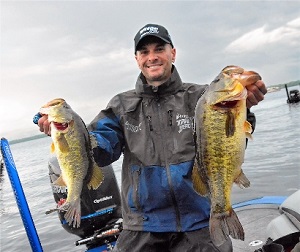
What does Randy Howell always have at the ready on his boat when bass fishing? Sure, a Livingston Lures crankbait would be a good guess, but you're guaranteed to find a jig when Howell is starting to breakdown a fishery. Specifically, a 3/8-ounce Lunker Lure Rattleback with a single rattle.
Nope, not for fishing slowly or just pitching cover. Howell uses this jig for power swim jigging.
"Everybody talks about swim jigging," said Howell. "I never knew about it until I moved to Alabama in 1998. I never did it in North Carolina. I learned how to use the power swim jigging method.
"A friend of mine in Alabama taught me. It is an excellent method to use in any shallow water. About five feet or less. I like to fish it fast and close to the surface. Mostly around grass, wood, floating docks, pads, any shoreline cover. Really get that jig  hopping and popping."
hopping and popping."
Howell isn't just casting and retrieving slowly like many anglers who fish a swim jig. He likes to get the lure moving. The proper line is a key component for successful power swim jigging.
"You need to use braided line for power swim jigging," said Howell. "I use 65-pound Daiwa J-Braid. I match that with a Steez 7'1" heavy casting rod and a Tatula CT reel with the 8.1 fast retrieve speed.
"That setup is excellent for being able to move the jig fast. Has plenty of power to move a big fish out of cover and is not so big that I can't twitch and pop the rod effectively to get that jig moving properly.
"One more thing about the braid that is important. It is key to attracting fish. It makes a clicking noise by the jig when you pop it during the retrieve. I believe that sound draws fish to the jig. Make sure you are using braid."
There's no need for a special swim jig when using the power method.
"I use a regular 3/8-ounce Lunker Lure jig," said Howell. "I use the jig with a 5/0 hook and a single rattle. I like that jig because it has a flat bottom on the head and it planes out and stays up in the water easier than the bullet heads associated with most swim jigs.
"I use either a white jig in stained water with a Yamamoto single or double tail trailer. Sometimes a green pumpkin trailer for contrast.
"In clearer water, I use a bream colored jig with the Yamamoto trailers to match.
"The double tail is better in cooler water. The single is better when I want to move it faster.
"I may not always be fishing the power swim jig method, but I always have one handy. I'm always trying it when I start out fishing in shallow water. When that bite is on, you can get big fish. It's fast and easy and a very high percentage of hookups turn into fish in the boat."
by Pros4- 1Source's Dave Landahl
- 4641 views

